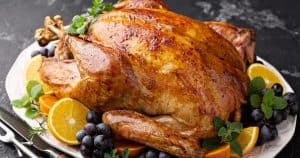
Turkey is a popular choice for sub sandwiches, deli meat, and is traditionally eaten during holidays like Thanksgiving and Christmas. But what nutritional value does it hold? How does it stack up to other protein-rich sources like chicken. Let’s compare the two types of meat.
Turkey and Chicken Nutritional Value
Below is a table comparing roasted chicken breast and chicken wings with roasted turkey breast and turkey wings:
| Total Calories | Sodium (mg) | Cholesterol (mg) | Saturated Fat (g) | Protein (g) | Iron (% Daily Value) | |
| Chicken Breast, Roasted | 170 | 70 | 75 | 3 | 23 | 6 |
| Chicken Wing, Roasted | 240 | 70 | 70 | 4.5 | 23 | 6 |
| Turkey Breast, Roasted | 160 | 55 | 60 | 2 | 24 | 6 |
| Turkey Wing, Roasted | 190 | 50 | 70 | 3 | 23 | 6 |
As you can see, they are fairly comparable in most aspects. Chicken breast and turkey breast are close in total calorie content, protein content and percent daily value of iron. Where they differ slightly is sodium content and cholesterol levels. Chicken breast is marginally higher in both sodium and cholesterol.
You’ll see more of a difference across the board when comparing chicken wings to turkey wings. Chicken wings are slightly higher in total calories, sodium, and saturated fat. They do, however, contain the same amount of protein and percent daily value of iron.
The choice then, may come down simply to tradition or taste. Which do you prefer? Which does your family eat on Thanksgiving? Let us know in the comments!
Check out our other Thanksgiving blogs:
- 2 Healthy Thanksgiving Recipes
- 9 Tips For Having a Healthy Thanksgiving
- The Truth About Turkey Consumption and Fatigue
If you have nutritional concerns about what you’re eating, come see me for a FREE nutrition consultation!
Schedule a Nutrition ConsultationWritten by Sarah Brunner, RDN, CD; Elite Sports Clubs Registered Dietitian
Sarah is certified in food allergies/intolerances and nutritional counseling, Academy of Nutrition and Dietetics; has a certificate in Dietetics from Mount Mary University; and a BA in Education and Mathematics from the University of Wisconsin – La Crosse.
